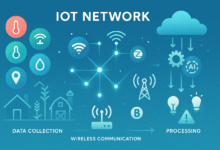
The Internet of Things (IoT) has quietly moved from being a buzzword to becoming part of daily life. A few years ago, smart homes were something only tech lovers spoke about. Today, even small-town families are using connected lights, voice assistants, and security cameras. On a larger scale, entire factories and farms run on connected devices.
But here’s the catch: IoT moves fast. The rules change. New chips, sensors, and platforms appear every month. Governments pass new laws. Competitors launch features overnight. No single company can keep up with it all.
This is why outsourcing internet research has become so important. Outsourcing provides IoT companies with fresh information, wider perspectives, and the freedom to focus on building rather than searching.
It’s like having a compass in a stormy sea; you may still face rough waters, but you won’t lose direction. Similar to a compass guiding a ship through a turbulent storm, you might still encounter challenges, but you will maintain your bearing.
The Scale of IoT Growth
Below, I want to share a few numbers that show how massive this field has become.
According to IoT Analytics, there were 16.6 billion IoT devices connected globally in 2023. And by the end of 2024, it would have reached 18.8 billion.
Fortune Business Insights had mentioned that the IoT market would hit USD 4 trillion by the end of 2032.
Also, according to Wikipedia-IIoT, factories that implement IoT for predictive maintenance are capable of cutting breakdowns by up to 70%, reducing costs by 30% and saving up to 12% over repairs.
Now, let’s consider it from a broader perspective. With multiple diverse regulations and industries involved, the amount of data and research will be enormous. In such a scenario, an internal team, regardless of its skill level, cannot track all of this data alone. Thus, outrouscing internet research comes to the rescue. Plus, one can also leverage B2B B2B lead generation strategies with web research services
Why In-House Research is Never Enough?
Most IoT firms already have engineers and analysts. But depending only on them for research is like asking a surgeon also to design hospital equipment while performing surgeries. Possible, yes. Practical, no.
- Time crunch – Product teams are already working on deadlines and fixes. Deep research needs time, but they don’t have it.
- Too many industries– IoT touches health, transport, farming, cities, and more. A small team can’t master them all.
- High costs – Establishing a large in-house research team is expensive. Salaries, training, and tools pile up quickly.
Hence, outsourcing web research is an affordable and feasible option. As per Deloitte’s report, approximately. 6 out of 10 companies choose to outsource at least one IT task to save money.
What are the Benefits of Outsourcing
Here’s where outsourcing makes a real difference:
1. Expert Knowledge
IoT research firms specialize in niche areas—like security protocols, telecom laws, or healthcare compliance. This depth is hard to build in-house.
2. Speed
Since research is their full-time job, external teams can deliver insights more quickly. When markets move in weeks, speed is survival.
3. Cost Control
Instead of paying for full-time researchers year-round, companies can “pay as they go.” Because outsourcing can cut costs by 40-60%.
4. Global Lens
Rules vary across continents. A team in Europe may know GDPR inside out, while a U.S. partner may focus on FCC labeling. Outsourced researchers bring this global view to the table.
5. More Innovation
When teams don’t get bogged down in research, they can focus on design and innovation. Outsourcing frees that space.
6. Competitive Edge
Companies that act on fresh insights faster often end up shaping the market instead of following it.
Regional Viewpoints of IoT Growth
Europe
The EU has strict rules on privacy and security. With GDPR and the new Cyber Resilience Act (European Commission), even small IoT firms must comply. Outsourced researchers act as guides through this maze.
United States
The U.S. drives IoT innovation while also introducing rules, such as the FCC IoT cybersecurity labeling program (FCC.gov). Outsourcing helps firms stay compliant without slowing launches.
Asia
Asia has been a busy hub of IoT, and it is growing rapidly. Smart cities in China, factory automation in Japan, and digital farming in India all create unique needs. Outsourced researchers help companies adapt to these diverse markets.
Real-world Example with Outsourcing
Here are a few real-life stories.
Farming in India: A leading agritech company outsourced research on soil sensors. The findings led to precision irrigation, which boosted yields by 20% and reduced water use (FasterCapital).
Hospitals in the U.S.: A healthcare company outsourced research on EU data regulations. That knowledge enabled them to launch remote monitoring for patients, resulting in a 30% reduction in hospital readmissions (FasterCapital).
Manufacturing in Germany: A factory wanted to predict machine breakdowns. Outsourced research revealed global best practices in predictive maintenance. The result: equipment efficiency rose by 15% (FasterCapital).
Outsourcing as a Growth Drive for Leaders
Think of outsourced research as a lighthouse. The sea of IoT is rough, with waves of regulation, competition, and fast tech changes. Without guidance, companies risk hitting rocks. With it, they steer safely to new opportunities.
Be clearer about what you want.
- Define goals clearly – Are you looking for market entry insights, competitor analysis, or compliance checks?
- Choose the right partners – Work with teams that truly understand IoT deeply and can speak your language.
- Ask for sources – Reliable partners don’t just give opinions, they provide solid data and sources to prove their findings.
- Stay in the loop – Keep the conversation going on, share the feedback and adjust as per t
- Apply the research – Use findings directly in strategy, design, and partnerships.
- Measure impact – Check how research improved costs, speed, or customer trust.
Future of IoT and Outsourcing
When people think about the future of IoT, they tend to imagine more devices — smarter homes, connected cars, entire cities with sensors running everything.
But the real transformation will happen when AI and IoT start working together. “And instead of machines merely doing response work, they will start to see patterns and act on them.” Imagine a machine on the floor of a factory that quietly learns the rhythm of production and tells engineers before something breaks.
Or a wearable health monitor that not only records heart rate but also learns when a person might be at risk and flashes an alert. To meet these shifts, companies will require ongoing research into new AI models and rule sets, and that’s where outsourcing comes in.
Outside specialists can track industry trends across industries, freeing businesses to focus on turning insights into real solutions.
Conclusion
The Internet of Things (IoT) is going through a phase of extreme growth. However, growth without proper information can be hazardous. That’s why outsourcing internet research isn’t just useful, but essential.
It helps you reduce costs, brings expert knowledge, accelerates findings, and keeps you and your company informed globally.
Above all, it allows leaders and teams to do what they do best: create solutions that can change lives.
So, the real question for you, the IoT leaders, is: Do you want your team to invest most of their time searching for the information, or do you want them to use the correct information to build the future? If your answer leans toward the second option, outsourcing research is the most brilliant move you can make.
Author Profile
This article is written by Sanju Stephen, co-founder of BolsterBiz. With over 10 years of experience, he helps businesses set up managed remote teams and accelerate growth through people-first outsourcing. When Sanju is not busy strategizing, supporting operations, and innovating for companies, he loves traveling, trying new cuisines, and exploring different cultures.











